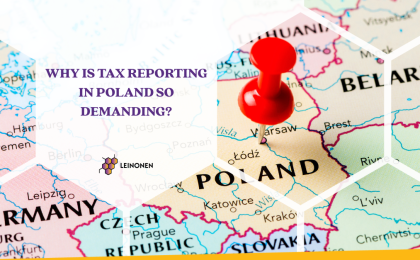The so-called Polish Order, which was signed in November 2021, introduced major changes to the Personal Income Tax Act and the Corporate Income Tax Act.
Most of the tax changes entered into force on January 1, 2022. At the same time, there are on-going preparations for the changes entering into force on 2023.
The tax changes implement new tax reliefs and preferences, but at the same time there are different types of new burdens for the tax payers, so it seems inevitable that the new regulations will have impact on the financials of the companies and individuals in Poland.
We’d like to present the most important ones.
1. CIT minimum – additional Income TAX
Tax on companies that are CIT taxpayers (including tax capital groups), which in the tax year:
➢ have suffered a loss from a source of income other than capital gains, or
➢ achieved the share of revenues from a source of revenues other than from capital gains in revenues other than from capital gains in the amount not greater than 1%
– is 10% of the tax base (minimum income tax).
The regulations do not apply to taxpayers:
1) in the tax year in which they started their business and in two consecutive tax years immediately following that tax year (except for entities created as a result of restructuring),
2) which are financial corporations within the meaning of Art. 15c of paragraph 1. 16 (financial enterprise),
3) if in the tax year their income was lower by at least 30% in relation to the income obtained in the tax year directly preceding that tax year,
4) with a “simple ownership structure”, ie those whose shareholders or partners are only natural persons and if the taxpayer does not have shares (stocks) in the capital of another company.
The tax base is the sum of:
➢ an amount corresponding to 4% of the value of revenues from a source of revenues other than from capital gains achieved by the taxpayer in the tax year and
➢ debt financing costs incurred on behalf of related entities in excess of 30% of the so-called tax EBITDA (similar to Art. 15c of the CIT Act – but without the exempt amount of PLN 3 million)
➢ purchase costs from related entities or from tax havens of certain services or intangible rights (existing Article 15e of the CIT Act – in the part exceeding PLN 3 million calculated according to the appropriate formula
➢ deferred income tax related to the disclosure of WNIP, resulting in an increase in gross profit or a decrease in gross losses.
When will we pay the tax?
We will settle the tax in the annual declaration. It will be possible to reduce it by the amount of CIT due under general rules. Moreover, the amount of the minimum income tax paid can be deducted from CIT in the next 3 years (assuming, of course, that the taxpayer’s economic situation improves sufficiently).
2. Interest on loans for capital transactions – non-deductible cost
Debt financing costs are not included in the tax deductible costs: incl. interest on loans and other costs of debt financing obtained from related entities (directly or indirectly), if the borrowed money will be used for equity transactions, in particular for:
➢ acquisition or subscription of shares (stocks),
➢ acquisition of all rights and obligations in a partnership,
➢ payment of additional payments,
➢ an increase in the share capital, or
➢ buyout of own shares for redemption.
3. Payment of hidden dividends – non-tax cost from 01/01/2023
Tax deductible costs, costs related to the provision of services, the beneficiary of which, directly or indirectly, is a partner or entity related directly or indirectly with the taxpayer or with this partner, shall not be included, if:
1) the amount of these costs or the date of their incurring in any way depend on the profit made by the taxpayer or the amount of profit or
2) a rationally operating taxpayer would not incur such costs or could bear lower costs if a comparable service was performed by an unrelated entity, or
3) these costs include remuneration for the right to use the assets that were owned or jointly owned by the partner (shareholder) or an entity related to the partner (shareholder) prior to the creation of the taxpayer.
Points 2 and 3 shall not apply if the sum of the costs incurred in the tax year, constituting the hidden dividend on the basis of these provisions, is lower than the amount of gross profit within the meaning of the accounting regulations, obtained in the financial year in which these costs were taken into account. in the taxpayer’s financial result
4. Deadlines – extension
- submission of local documentation at the request of the tax authority – 14 days
- preparation of local file documentation – by the end of 10 months after the end of the entity’s tax year
- preparation of TP-R – by the end of the 11th month after the end of the entity’s tax year Statement
Liquidation of the statement on the preparation of price documentation as a separate document and transfer of the statement in the modified content to the information on transfer prices (TPR-C / TPR-P).
5. New cash payment limits for entrepreneurs:
Making or accepting payments related to the conducted business activity takes place via the entrepreneur’s payment account, in each case when:
➢ a party to the transaction from which the payment results is another entrepreneur and
➢ the one-off value of the transaction, regardless of the number of payments resulting therefrom, exceeds PLN 8,000 or its equivalent – Art. 19 of the draft Act – Entrepreneurs’ Law.
Taxpayers do not include the cost of obtaining revenue costs in that part, in which the payment for the transaction referred to in article 1. 19 of the Act of March 6, 2018 – Entrepreneurs’ Law:
1) was made without the use of a payment account or
2) was made by bank transfer to an account other than that entered into on the date of the transfer order in the list of entities, the so-called “White List”
3) despite the words “split payment mechanism” being included in the invoice, it was made without the split payment mechanism
6. Tax reliefs supporting innovation
➢ R&D tax relief supporting conceptual work on a new product.
➢ Relief for a prototype supporting the transfer of an idea into the language of practice and production.
➢ Relief for supporting innovative employees, facilitating competition for specialists with key skills and competences.
➢ Discount for robotization, which will facilitate the opening of a production line dedicated to the product.
➢ Possibility of simultaneous use of R&D relief and IP Box relief, reducing the burden at the stage of its sale
What expenses can be deducted?
-remuneration
-materials
-external services
-patents
-apparatus
-depreciation
7. Sending books in electronic form
Entities running a business will be required to keep accounting books, tax records of revenues and expenses, and records of fixed assets and intangible assets using computer programs.
-Monthly – tax books will be sent by the 20th day of the following month, if the income is determined on the basis of the books and records, on which monthly advances are made. (PIT)
– Quarterly – books will be sent by the 20th day of the month immediately following the end of the quarter, if the income is determined on the basis of the books and records, on which quarterly advances are made. (PIT)
-After the end of the year – the books will be sent by the deadline for submitting the tax return. (PIT and CIT)
The obligation to keep books and send them electronically will enter into force on 1 January 2023.
8. Tax sanctions for employers who employ illegally
– the employer’s income will be the remuneration of an illegally employed employee
– such remuneration and social security contributions will be excluded from the costs of obtaining revenues
– the employer will bear the costs of ZUS contributions for the employee
9. Settlement of loss
For the amount of the loss from the source of income incurred in the tax year, the taxpayer may:
– reduce the income obtained from this source in the next 5 tax years, however the amount may not be reduced by more than 50% of the amount of this loss
-reduce one-off income by an amount not exceeding PLN 5 million, the underestimated amount is subject to settlement in the remaining years of this 5-year period, except that the amount
New regulations implemented by Polish Parliament in Poland regarding VAT for 2022/beginning of 2023
1.VAT Group – a group of related entities (i) financially, (ii) economically and (iii) organizationally, registered as a VAT taxpayer
(i) if one of the taxpayers holds directly more than 50% of the share capital of the rest
(ii) the members’ activities are of the same nature or are complementary and interdependent, or one of the members of the group carries out activities that the other members get profit from
(iii) by the law or actually they are under the same management or organize their activities in common agreement
2.No VAT on transactions within capital groups.
Financially, economically and organisationally related entities will be able to form VAT groups. As a result of this change, transactions within the group will be tax neutral.
3.Structured invoices (e-invoices)
A new type of sales invoices will be issued using the template provided by the Ministry of Finance. Structured invoices will be considered issued on the day of their transmission to the National e-Invoice System.
a) In 2022 optional
b) From 01.2023 OBLIGATORY – it is necessary to adapt accounting systems to the requirements of issuing and sending structured invoices
New Polish Order 2022 – personal income tax changes from 2022
1. New amount reducing tax and tax threshold
2. No deduction of health insurance contribution
3. Tax Relief for the middle class
| 2021 legal status | Change New Polish Order 2022 | |
| 1 | Tax-free allowance | Tax-free allowance |
| PLN 8 000,00 | PLN 30 000,00 | |
| 2 | tax threshold | tax threshold |
| PLN 85528,00 | up to PLN 120 000,00 | |
| 3 | health care contribution | health care contribution |
| 7.75% deduction of health insurance from tax | No deduction of health insurance from tax | |
| 9% health premium calculated on income | ||
| The value of the health insurance contribution will be deducted from the net salary | ||
| 4 | no middle-class tax relief | PIT relief for the middle class: for people employed under a contract of employment with a monthly income from PLN 5.701,00 to PLN 11.141,00 gross |
| no discount for persons over PLN 11.141,00 gross |
Ad 1 New amount that reduces tax and tax threshold
In 2021 the tax-free amount is PLN 8.000,00. In 2022 the new tax-reducing amount will increase
• from PLN 8.000,00 up to PLN 30.000,00 per year.
• from PLN 43,76 up to PLN 425,00 per month
The tax reduction amount is also to be available to the taxpayers in the 2nd tax threshold, who will pay 32% tax.
Raising the tax threshold,
In 2021, it amounts to PLN 85,528. In 2022 the new tax thresholds will be as follows:
• the first tax threshold, i.e. 17%, will apply up to PLN 120.000,00 per year
• the 2nd tax threshold, i.e. 32%, applies to the amount of income exceeding PLN 120,000 per year.
Income obtained by an employee, or a contractor is exempt from collection of income tax advance up to PLN 85.528,00 for the following 4 groups of employees:
1) A taxpayer under the age of 26
2) A taxpayer who in the tax year have at least four children (referred to in art. 27ea paragraph. 1 point 2 of the Act), exercised parental authority, acted as a legal guardian, if the child lived with him, or performed the function of a foster family on the basis of a court decision or an agreement concluded with the starost, and in the case of adult learning children – he performed the maintenance obligation imposed on him or her foster family function. Both the mother and father of the children will benefit from the exemption.
3) The taxpayer at the age of 60 for a woman and 65 for a man, and he/she is subject to social insurance and not receiving a retirement pension or disability pension
4) A taxpayer who transferred his place of residence from another country to the territory of the Republic of Poland (in four consecutive tax years, counting from the beginning of the year in which the taxpayer transferred his place of residence, or from the beginning of the next year). This applies to selected countries indicated in the act (belonging to the EU, EEA, Swiss Confederation, but also in Australia, Japan, Canada, Great Britain or the USA), e.g. someone who changed his place of residence to Poland in 2022 has the right to tax exemption for 4 consecutive years. Exemption applies to people returning after December 31st 2021.
In order to take advantage of the exemption in points 2-4, a statement must be submitted, which will show that the employee is entitled to this exemption.
Ad. 2 No deduction of health contributions
One of the most important changes is the inability to deduct health insurance from tax. Currently, the contribution payer could reduce the tax by 7,75% of the health insurance contribution base. The New Polish Order will completely change the tax calculation mechanism, the health insurance contribution will not be tax deductible
Ad. 3 Relief for the middle class
Relief for the middle class is another completely new solution that aims to protect the middle class from the effects of the introduced changes.
·In practice, if the employee earns monthly income from an employment contract from PLN 5.701,00 gross to PLN 11.141,00 gross, the tax remitter will be able to apply this relief to reduce the tax base.
·However, if the employee achieves a gross income of less than PLN 68.412,00 gross or more than PLN 133.692,00 gross, the tax credit is not due.
This means that the difference resulting from the middle-class allowance calculated in a given month will be required by the employee to return to the Tax Office together with the annual PIT settlement. The relief is settled on a monthly basis.
Example:
• The income of an Employee for 1 month is PLN 6.000,00, the calculated allowance for the middle class is PLN 119,41
• The annual revenue is PLN 134.000,00 gross – the employee returns the amount of PLN 119,41 to the Tax Office
If the taxpayer submits a written application for not reducing income by the amount of middle-class relief, the taxpayer does not count the relief; the application is submitted separately for each tax year and applies no later than the month following the month in which the employer received the application.
In practice:
1) If the employee resigns from calculating the allowance for the middle class, he will be able to settle any refund in an annual settlement with the Tax Office and receive the refund.
2) If, on the other hand, an event occurs where the employee is not entitled to a tax relief, because, for example, he will not earn such income, because he will lose his job during the year and will not receive the minimum threshold (68,412) or exceed (133,692), i.e. the income will be too high, he will have to return the previously calculated discount to the Tax Office at the end of the year.
Entrepreneurs or persons employed under civil law contracts will not benefit from the relief for the middle class.
The new tax relief will also benefit authors and artists who apply 50% of their copyright tax-deductible costs





